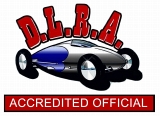 DLRA Accredited Officials Training
DLRA Accredited Officials Training
INTRODUCTORY MODULE
STARTER - Lv1
The starter is responsible conducting safety checks and releasing vehicles at the start line for and is also responsible for ensuring the competition is conducted safely.
It is the starters role to coordinate between the Timer and the Fire and Rescue Crews as to when the track is clear and the next entrant can proceed down the track.
The starters assistants are responsable for last minute safety checks, keeping entrants in the right queues and keeping unauthorised people out of the staging and start line areas.
There is a detailed specific unit for starters to read and understand.
The Learning Objectives of this module are:
- Demonstrate knowledge and application of Starting in a land speed environment.
- Apply communication techniques appropriate to technical inspections.
- Identify critical incident procedures and manage it in accordance with the officials functions.
- Demonstrate a clear understanding of radio etiquette techniques and hand signal techniques for DLRA events and demonstrated ability to apply them.
PROCEDURE
The starter is charged with the responsibility of controlling when entrants and their vehicles can leave the start line. The starter operates in a defined start line area. Only other start line officials are permitted in the start line area. Entrants and crew are strictly forbidden from talking to the Starter. They will only talk to the starter if he asks them a direct question.
The starter must ensure the track is in a fit and safe state prior to releasing an entrant. He does this by monitoring the UHF DLRA private channel radio.
- The Fire and Rescue crew will broadcast a message over the UHF radio to confirm a "Track Clear" when the previous entrant has safely exited the track.
- And the Timer will confirm via the UHF radio that the timing system is "Armed and Ready".
Only then will the timer release the vehicle on the start line via a direct and easily understood hand signal.
As the vehicle leaves the starter will notify timing and the fire and rescue crews via the UHF radio that "The vehicle has left the line".
TEAM MEMBERS AND RESPONSABILITIES
The Chief Starter is also a team leader for both start lines, and will coordinate the assistants.
Typically there will be 3 start line assistants at any time on track 1 and 2 start line assistants on track 2.
- The first assistant with be conducting checks of the entrants safety equipment and vehicles in what is called the staging area..
- The second assistant will be directing the entrants where and how to queue behind the staging area.
They will also direct the tender vehicles where they are to park in their own dedicated lane
They will also take the pre-stage running sheet from the first vehicle in the group to come from pre-stage and deliver that to the Timing Data Entry person in the Starters Van.
They will also prompt the entrants as to when they need to start to suit up and advise roughly how long before they are likely to start. - The third assistant is there as a backup, should the need arise or to assist as directed. They are also what we call a "wrangler", to ensure general safety at the start line. This mainly involves keeping spectators and other unauthorised people behind the spectator barricades. And to monitor an members of the media, that they do not get in the way of the entrants or their teams.
TRACKS
There are two tracks used for Speed Week.
Track 1 is 9 miles long and comprises 2 courses, a short course and a long course.
Track 2 is 4 miles long and is a short course track only.
There is a separate UHF DLRA private channel for each track.
For more information you must read Track Layout and Marking
LANES
On track 1 there are 3 lanes or queues for the entrants to use.
Lane 1 and 3 are for cars and bikes.
Lane 2 is specifically for streamliners and other very fast vehicles, that take a longer than normal time to prepare for a run. Lane 2 is in the middle of the track for a reason.
For more information you must read Start Line
START LINE SAFETY CHECK PROCEDURES - CARS AND TRUCKS
The first starters assistant will conduct these checks on each vehicle before permitting it to proceed to the start-line.
- Check inspected sticker for correct entrant number.
- Check valve caps on all wheels, must be metal caps
- Safety belts - clamp down, must not be able to force hand between belt and body
- Helmet strap secure - barely room for finger between strap and chin
- Wrist restraints - check mounting and wrist fit, not required if safety net fitted
- Neck brace - required for vehicles with speeds over 125 MPH
- Racing suit / overalls - fastened and zipped to neck
- Fire extinguishers - check safety release pins removed
- Parachute pins - check safety pin removed
- Gloves - on
- Helmet visor - down
- Windows - Up
- Doors - shut tightly
START LINE SAFETY CHECK PROCEDURES - MOTOR CYCLES
- At staging line - fuel on
- Helmet strap secure - barely room for finger between strap and chin
- Zip on Leathers - Pulled up to top of jacket, neck clip fastened
- Boots - fastened
- Kill switch - lanyard connected
- Gloves on - fastened
- Helmet - visor down or goggles on
Tasks
Once you have completed this unit, submit details below for Accreditation